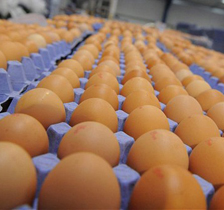Australia studies environmental management of egg industry

A study by the Australian Egg Corporation Limited has demonstrated the efficiency of Australian egg production with respect to three important environmental and resource efficiency issues: global warming, water use and energy use.
The study, ‘Environmental Assessment of an Egg Production Supply Chain using Life Cycle Assessment’, is the first of its type for the Australian egg industry and establishes a performance benchmark for the future.
Environmental management is an important focus area for the Australian egg industry. Modern production systems have led to continual productivity improvements across the industry, which will in turn result in a high degree of environmental efficiency.
Highly efficient production systems
The Australian egg industry is characterised by intensive, modern, highly efficient production systems and a growing free range production sector, which together produce some 345 million dozen eggs annually. The industry aims to have a high degree of environmental performance through adoption of best management practices for a range of environmental issues although, to-date, there have been no comprehensive analyses of environmental performance across the whole egg supply chain.
In order to quantify the most important environmental and resource impacts faced by the industry, a life cycle assessment (LCA) study was commissioned to investigate emissions of greenhouse gases, energy and water use. This study investigated both caged and free range egg production through to the end of the primary production supply chain, using a functional unit of one kilogram of eggs produced.
Low levels of greenhouse gas
Australian egg production was found to generate low levels of greenhouse gas (GHG) when compared with egg production from European studies. Total GHG was 1.3 +/- 0.2 kg CO2-e / kg eggs from caged production and 1.6 +/- 0.3 kg CO2-e / kg for free range production. Despite the overlapping confidence intervals, free range production generated higher emissions than caged production when shared variability was taken into account.
Cumulative energy demand (CED) for caged production (10.7 +/- 0.9 MJ / kg eggs) was lower than studies previously reported in the literature. Cumulative energy demand for free range egg production (13.1 +/- 1.1 MJ / kg eggs) was slightly higher than for caged production, but was similar to other studies reported in the literature.
The higher impacts for GHG and CED associated with free range production were attributable to higher feed conversion ratio (FCR) and lower productivity compared to caged production.
Environmental efficiency of egg production
The relative environmental efficiency of egg production in this study arose from the high performance of modern Australian egg production coupled with the low input nature of Australian grain production. Additionally, Australian grain is produced in conditions that do not favour nitrous oxide emissions, which is reflected in the lower emission factor recommended for use in the Australian inventory (DCCEE 2010). These result in low GHG and energy use for Australian eggs, both in the caged and free range systems.
Related website:
Australian Egg Corporation Limited
Join 31,000+ subscribers
Subscribe to our newsletter to stay updated about all the need-to-know content in the poultry sector, three times a week. Beheer
Beheer








 WP Admin
WP Admin  Bewerk bericht
Bewerk bericht